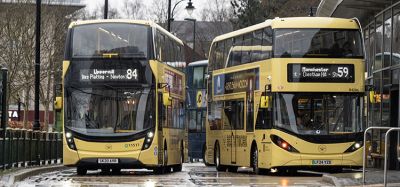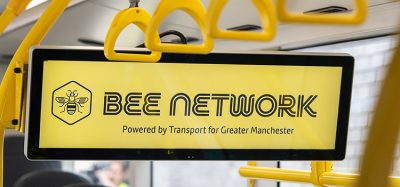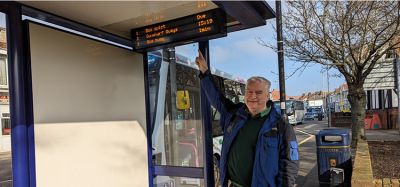Opportunities for growth
- Like
- Digg
- Del
- Tumblr
- VKontakte
- Buffer
- Love This
- Odnoklassniki
- Meneame
- Blogger
- Amazon
- Yahoo Mail
- Gmail
- AOL
- Newsvine
- HackerNews
- Evernote
- MySpace
- Mail.ru
- Viadeo
- Line
- Comments
- Yummly
- SMS
- Viber
- Telegram
- Subscribe
- Skype
- Facebook Messenger
- Kakao
- LiveJournal
- Yammer
- Edgar
- Fintel
- Mix
- Instapaper
- Copy Link
Posted: 22 January 2013 | Andrej Osterman, Senior Consultant to the CEO, LPP | No comments yet
Four years ago we published an article about implementing long-term goals for the city of Ljubljana. Now we would like to report on what has been done since then.
Ljubljana, the capital of Slovenia and the country’s largest city, is the centre of Slovenian economy, politics, culture and transport. It is located almost in the middle of Slovenia at the crossing of main roads running from north to south and east to west of Europe. The distance from Ljubljana to Vienna is 380km, to Munich 410km and to Venice 240km.
Ljubljana’s main provider of public pass – enger transport is LPP (Ljubljana Public Transport), a limited liability public company 100% owned by the City of Ljubljana, which operates public transport services by bus only. Ljubljana has approximately 260,000 inhabitants and including the population of surrounding villages and towns, LPP serves approximately 360,000 people.
Each working day, 120,000 people comm – ute to Ljubljana to work or study and only 15% of them use public transport. The part of public transport for all transport modes moves around 15%. As a result of such a modal split heavy congestion can be found at peak hours. Twenty-seven bus lines currently operate in the city and another 32 bus lines in the suburban area. At present, the company employs 877 staff, of which 552 are bus drivers.
Four years ago we published an article about implementing long-term goals for the city of Ljubljana. Now we would like to report on what has been done since then. Ljubljana, the capital of Slovenia and the country’s largest city, is the centre of Slovenian economy, politics, culture and transport. It is located almost in the middle of Slovenia at the crossing of main roads running from north to south and east to west of Europe. The distance from Ljubljana to Vienna is 380km, to Munich 410km and to Venice 240km. Ljubljana’s main provider of public pass - enger transport is LPP (Ljubljana Public Transport), a limited liability public company 100% owned by the City of Ljubljana, which operates public transport services by bus only. Ljubljana has approximately 260,000 inhabitants and including the population of surrounding villages and towns, LPP serves approximately 360,000 people. Each working day, 120,000 people comm - ute to Ljubljana to work or study and only 15% of them use public transport. The part of public transport for all transport modes moves around 15%. As a result of such a modal split heavy congestion can be found at peak hours. Twenty-seven bus lines currently operate in the city and another 32 bus lines in the suburban area. At present, the company employs 877 staff, of which 552 are bus drivers.
Four years ago we published an article about implementing long-term goals for the city of Ljubljana. Now we would like to report on what has been done since then.
Ljubljana, the capital of Slovenia and the country’s largest city, is the centre of Slovenian economy, politics, culture and transport. It is located almost in the middle of Slovenia at the crossing of main roads running from north to south and east to west of Europe. The distance from Ljubljana to Vienna is 380km, to Munich 410km and to Venice 240km.
Ljubljana’s main provider of public pass – enger transport is LPP (Ljubljana Public Transport), a limited liability public company 100% owned by the City of Ljubljana, which operates public transport services by bus only. Ljubljana has approximately 260,000 inhabitants and including the population of surrounding villages and towns, LPP serves approximately 360,000 people.
Each working day, 120,000 people comm – ute to Ljubljana to work or study and only 15% of them use public transport. The part of public transport for all transport modes moves around 15%. As a result of such a modal split heavy congestion can be found at peak hours. Twenty-seven bus lines currently operate in the city and another 32 bus lines in the suburban area. At present, the company employs 877 staff, of which 552 are bus drivers. The company runs a fleet of 206 urban and 54 suburban buses and at peak hours on working days, the lines are serviced by 238 buses. The annual line mileage in 2011 was 14.3 million kilometres and 43.7 million passengers were carried. Total revenue, including a subsidy from the munici – pality of Ljubljana and from the state was €37.9 million and operating expenses were €46.9 million. The result: a €9 million loss.
URBANA
In 2010, LPP introduced a universal travel pass called URBANA. It is a contactless smartcard that enables quick and convenient cashless payment for use on the city’s urban and suburban buses. The URBANA card can also be used on the funicular to Ljubljana castle, for parking in white zones and in car parks owned by the city of Ljubljana. In the near future, it will also be possible to use the URBANA card to pay for library services, museum visits and sporting and cultural events. The core technology of the URBANA card is Mifare chip EV1 with 8k memory and a 256 bit inscription. It allows up to 50 different services to be loaded.
Together with the introduction of the URBANA card, LPP has also set up, on the most frequent stops, 39 vending machines called URBANOMATs, which are in operation 24 hours a day. URBANOMATs allow passengers to buy URBANA cards, load or reload them with credit of up to €50 or just check the value on the card. Passengers can also carry out the URBANOMATs operations at all other 161 selling points around Ljubljana.
There are two types of URBANA card. The first is the URBANA Value Card which has replaced tokens and cash. It does not have the holder’s name on it and it is transferrable. It is possible to add credit to the card up to a total of €50. The lowest amount that can be credited at an URBANOMAT is €1, although there is no restriction on the lowest amount at other sales outlets.
The second card is the URBANA Periodic Card which replaces all types of monthly passes. The bearer’s name is on the card and it is nontransferrable. An unlimited number of journeys on all bus lines are permitted. But, it is only possible to get a Periodic Card at the passenger ticket office at the LPP depot and at Ljubljana bus stations, where the right to use individual types of monthly passes is inscribed. Toppingup of Periodic Cards is possible at URBANOMATs and all other sales points, where the validity of the card for the selected month is extended via payment of the selected monthly ticket. Instead of a monthly ticket, passengers can also put a selected credit value (up to €50) on the card and use it to pay for public transport or other services included in the city card uniform system. If passengers have a valid monthly travel pass loaded on their Periodic Card, the system takes note of this and does not take the cash value of the funds, but if the system detects that there is no valid monthly travel pass loaded on the Periodic Card, then the cost of the journey is automatically deducted from card’s credit value.
Real-Time Information
In order to make public transport more attractive, 54 bus shelters have been equipped with 58 information displays, featuring realtime bus arrival count downs for waiting passengers. Another 48 displays are under construction and will be in operation by the end of 2012. All stops are displayed with timetables with exact departure times of the buses on that specific station.
CNG buses
LPP is aware of the importance of sustainable development and mobility and has therefore already set up a strategic objective to reduce the environmental impact of its activity. A few years ago, to reduce emissions of carbon dioxide, we experimented with a mixture of gasoil (50%) and vegetable oils (50%). But following some problems in the winter and the emergence of bad smells around stops, we stopped the project.
In 2010 we tested hybrid buses, but we did not achieve the assured reduction in fuel consumption from the manufacturers. The reduction in fuel consumption was only 10-15% compared to equivalent vehicles of con – ventional propulsion.
Considering the high price of the hybrid buses and low saving in fuel costs, we have now turned our attention towards buses that run on natural gas (CNG buses). In fact, we have just continued the gas bus project from 1996 when we already had two CNG buses.
At the end of 2011, 20 standard IRISBUS CITELIS CNG buses were acquired. The buses are low-floor, with automatic gearboxes and equipped with air conditioning, video-sur – veillance, radio alarm, protected driver’s cabin, digital equipment for acoustic and visual announcements of the next stop, infotainment systems, automatic vehicle location and a mechanical wheelchair ramp. On the roof of the bus there are eight CNG cylinders, each with a 155 litre capacity. The buses comply with EEV standard for exhaust gas emissions.
The public company Energetika Ljubljana, distributor and supplier of natural gas and heat to tariff consumers in Ljubljana, has erected a fast-fill CNG station nearby our bus depot. The filling station consists of two compressors with a maximal flow of 210 Nm3 per hour and maximal outlet pressure 300 bar. In order to fuel buses quickly, gas must be drawn from pre-pressurised storage vessels. In our case we have storage vessels with a total capacity of 4,480 litres, CNG at 300 bar. The filling time required to fill the tank of the bus from 60 to 200 bar is approxi – mately six minutes.
From December 2011 to November 2012, CNG buses have run approximately 60,000 kilometres each, without any main problems. The average consumption is 39.4kg of natural gas per 100 kilometres. Now it is our bus strategy to replace 50% of our urban diesel buses with CNG buses. We hope to make this change by 2016.
Conclusion
Despite all mentioned improvements, the number of transported passengers decreased in the period from 2008 to 2011. For 2012 and for the years to come, we expect an increase in the number of public transport users, because some lines have been extended from urban to suburban areas and the prices of suburban transport were reduced. On the other hand, the opportunities for growth in the public transport market depend largely on policy measures made by local authorities (dedicated bus lanes, parking policies, amount of subvention). We expect decisions in favour of the public transport.
About the author
Andrej Osterman graduated from the Faculty of Mechanical Engineering at the University of Ljubljana. In 1977 he started to work as an Engineer at a project engineering company in Ljubljana. He then worked at the Department of the Interior, and in 1982 joined LPP as a Director’s Assistant but quickly progressed onto a Director of Urban Public Transport. In 1988 he was appointed to General Manager of LPP until 2003 when he became the Executive Director. Since 2010 Andrej has been the Senior Consultant to the CEO.








